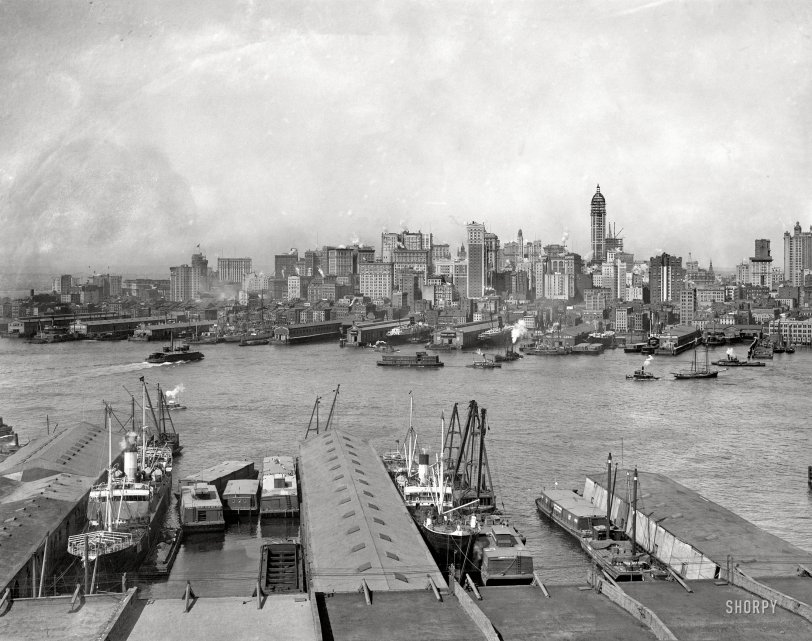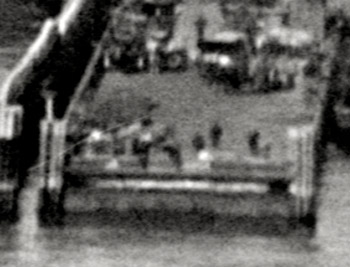


Framed or unframed, desk size to sofa size, printed by us in Arizona and Alabama since 2007. Explore now.
Shorpy is funded by you. Patreon contributors get an ad-free experience.
Learn more.

- Baldwin 62303
- Baldwin VO-1000
- Cold
- No expense spared
- Tough Guys
- Lost in Toyland
- And without gloves
- If I were a blindfolded time traveler
- Smoke Consumer Also Cooks
- Oh that stove!
- Possibly still there?
- What?!?
- $100 Reward
- Freeze Frame
- Texas Flyer wanted
- Just a Year Too Soon
- WWII -- Replacing men with women at the railroad crossing.
- Yes, Icing
- You kids drive me nuts!
- NOT An Easy Job
- I wonder
- Just add window boxes
- Icing Platform?
- Indiana Harbor Belt abides
- Freezing haze
- Corrections (for those who care)
- C&NW at Nelson
- Fallen Flags
- A dangerous job made worse
- Water Stop
Print Emporium
The Heart of New York: 1907

Circa 1907. "The heart of New York (Manhattan skyline from Brooklyn)." The Singer Building rises. 8x10 glass negative, Detroit Publishing Co. View full size.
What's going on here?
Heavy traffic out there! Up until the 1960s-1970s, various railroads transferred huge amounts of cargo to and from the city by barges called carfloats carrying rail cars. Several railroads had small switching yards isolated from their main lines fed by carfloats, plus warehouses as well. Those railroads also often had their own “navies” of tugs and barges to transfer cargo to and from ships in the harbor..
Note the covered barges (AKA house barges) in the foreground marked for the Lehigh Valley RR. The one at far right is owned by the Lackawanna RR. The covering structure allowed secure storage and protected cargo from the weather during transfer. Covered barges had side doors to allow direct transfer to freighters that also had side doors. The freighter in foreground right looks to be transferring cargo via one of the barge’s roof hatches located over its side door.
At far left are 2 hold barges, apparently one with coal being loaded onto the ship alongside. Those barges were mostly owned by coal companies.
A stick lighter (AKA gas hoister) is at bottom right with others elsewhere in the picture. Essentially a derrick on a barge, they were used to handle heavy/bulky items. The bigger one opposite is a self-propelled steam lighter. Those were used for making faster transfers of goods – no waiting for tug service.
A good reference is “New York Harbor Railroads in Color, Volume 1” by Thomas R. Flagg (Morning Sun Books, 2000)
Transportation History Divined
I just realized how the waterfront railroad terminals in New Jersey worked!
If you look closely, several of the barges are from the Lehigh Valley Railroad, which ran from that region of Pennsylvania to Jersey City. I must presume that the goods that were to be transshipped from freight cars to ships or the city itself were loaded on to barges and then delivered to the deep water piers in Brooklyn and Manhattan for delivery in the city or loading on to ocean going vessels. Thus explaining why all the great photographs I've seen on Shorpy feature so many small barges, lighters, and other riverine craft.
I imagine the completion of the New York Central Railroad's High Line was a serious blow to the LVRR and other lines on the New Jersey side of the Hudson and the Holland Tunnel doubly so. Imagine what New York City would be like if there had been a more efficient rail system from New Jersey to the docklands of the East River.
How did it take me so long to figure this out?!
Tall Ships
It is interesting to see ships with masts and sails plying the waters around Manhattan. There is a large three masted ship tied up to the pier, slightly left of center. I can remember going to The South Street Seaport Museum to look at the Peking and the Wavertree.
Indecently, the South Street Seaport Museum is located at Pier 16 On the East River. Pier 16 is the right hand pier of the two Mallory Line Piers.
Singer Tower
The Singer (sewing machine company) tower, under construction was the tallest building in the world for a couple of years. It was demolished at a youthful 60-years old.
Even Today
The best views of Manhattan are from Brooklyn, Queens and New Jersey.
Ghost Town
Not a soul in sight!
[They are there, just really tiny. - Dave]

























On Shorpy:
Today’s Top 5